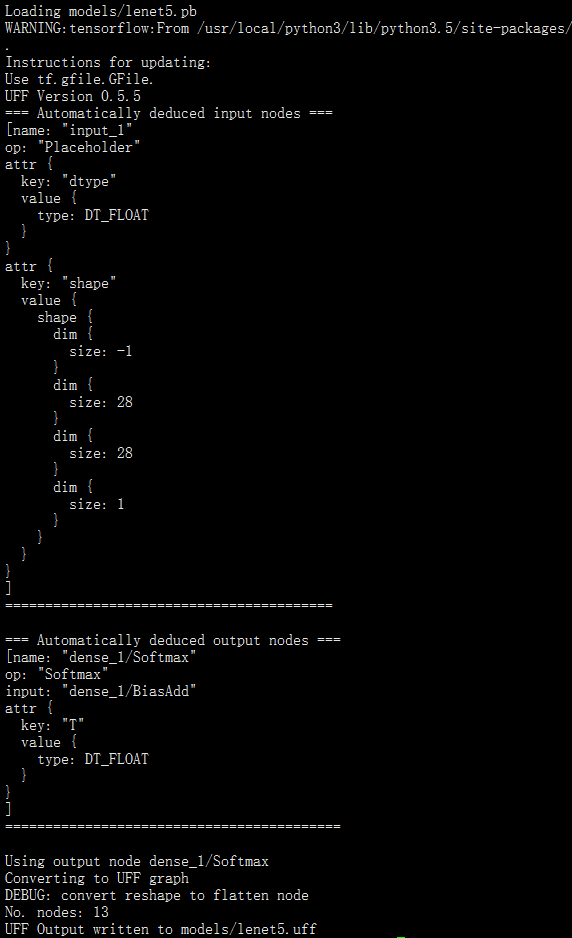TensorRT&Sample&Python[end_to_end_tensorflow_mnist]
本文是基于TensorRT 5.0.2基础上,关于其内部的end_to_end_tensorflow_mnist例子的分析和介绍。
1 引言
假设当前路径为:
TensorRT-5.0.2.6/samples
其对应当前例子文件目录树为:
# tree python
python
├── common.py
├── end_to_end_tensorflow_mnist
│ ├── model.py
│ ├── README.md
│ ├── requirements.txt
│ └── sample.py
2 基于tensorflow生成模型
其中只有2个文件:
- model:该文件包含简单的训练模型代码
- sample:该文件使用UFF mnist模型去创建一个TensorRT inference engine
首先介绍下model.py
# 该脚本包含一个简单的模型训练过程
import tensorflow as tf
import numpy as np
'''main中第一步:获取数据集 '''
def process_dataset():
# 导入mnist数据集
# 手动下载aria2c -x 16 https://storage.googleapis.com/tensorflow/tf-keras-datasets/mnist.npz
# 将mnist.npz移动到~/.keras/datasets/
# tf.keras.datasets.mnist.load_data会去读取~/.keras/datasets/mnist.npz,而不从网络下载
(x_train, y_train),(x_test, y_test) = tf.keras.datasets.mnist.load_data()
x_train, x_test = x_train / 255.0, x_test / 255.0
# Reshape
NUM_TRAIN = 60000
NUM_TEST = 10000
x_train = np.reshape(x_train, (NUM_TRAIN, 28, 28, 1))
x_test = np.reshape(x_test, (NUM_TEST, 28, 28, 1))
return x_train, y_train, x_test, y_test
'''main中第二步:构建模型 '''
def create_model():
model = tf.keras.models.Sequential()
model.add(tf.keras.layers.InputLayer(input_shape=[28,28, 1]))
model.add(tf.keras.layers.Flatten())
model.add(tf.keras.layers.Dense(512, activation=tf.nn.relu))
model.add(tf.keras.layers.Dense(10, activation=tf.nn.softmax))
model.compile(optimizer='adam', loss='sparse_categorical_crossentropy', metrics=['accuracy'])
return model
'''main中第五步:模型存储 '''
def save(model, filename):
output_names = model.output.op.name
sess = tf.keras.backend.get_session()
# freeze graph
frozen_graph = tf.graph_util.convert_variables_to_constants(sess, sess.graph.as_graph_def(), [output_names])
# 移除训练的节点
frozen_graph = tf.graph_util.remove_training_nodes(frozen_graph)
# 保存模型
with open(filename, "wb") as ofile:
ofile.write(frozen_graph.SerializeToString())
def main():
''' 1 - 获取数据'''
x_train, y_train, x_test, y_test = process_dataset()
''' 2 - 构建模型'''
model = create_model()
''' 3 - 模型训练'''
model.fit(x_train, y_train, epochs = 5, verbose = 1)
''' 4 - 模型评估'''
model.evaluate(x_test, y_test)
''' 5 - 模型存储'''
save(model, filename="models/lenet5.pb")
if __name__ == '__main__':
main()
在获得
models/lenet5.pb
之后,执行下述命令,将其转换成uff文件,输出结果如
'''该converter会显示关于input/output nodes的信息,这样你就可以用来在解析的时候进行注册;
本例子中,我们基于tensorflow.keras的命名规则,事先已知input/output nodes名称了 '''
[root@30d4bceec4c4 end_to_end_tensorflow_mnist]# convert-to-uff models/lenet5.pb
Loading models/lenet5.pb

3 基于tensorflow的pb文件生成UFF并处理
# 该例子使用UFF MNIST 模型去创建一个TensorRT Inference Engine
from random import randint
from PIL import Image
import numpy as np
import pycuda.driver as cuda
import pycuda.autoinit # 该import会让pycuda自动管理CUDA上下文的创建和清理工作
import tensorrt as trt
import sys, os
# sys.path.insert(1, os.path.join(sys.path[0], ".."))
# import common
# 这里将common中的GiB和find_sample_data,allocate_buffers,do_inference等函数移动到该py文件中,保证自包含。
def GiB(val):
'''以GB为单位,计算所需要的存储值,向左位移10bit表示KB,20bit表示MB '''
return val * 1 << 30
def find_sample_data(description="Runs a TensorRT Python sample", subfolder="", find_files=[]):
'''该函数就是一个参数解析函数。
Parses sample arguments.
Args:
description (str): Description of the sample.
subfolder (str): The subfolder containing data relevant to this sample
find_files (str): A list of filenames to find. Each filename will be replaced with an absolute path.
Returns:
str: Path of data directory.
Raises:
FileNotFoundError
'''
# 为了简洁,这里直接将路径硬编码到代码中。
data_root = kDEFAULT_DATA_ROOT = os.path.abspath("/TensorRT-5.0.2.6/python/data/")
subfolder_path = os.path.join(data_root, subfolder)
if not os.path.exists(subfolder_path):
print("WARNING: " + subfolder_path + " does not exist. Using " + data_root + " instead.")
data_path = subfolder_path if os.path.exists(subfolder_path) else data_root
if not (os.path.exists(data_path)):
raise FileNotFoundError(data_path + " does not exist.")
for index, f in enumerate(find_files):
find_files[index] = os.path.abspath(os.path.join(data_path, f))
if not os.path.exists(find_files[index]):
raise FileNotFoundError(find_files[index] + " does not exist. ")
if find_files:
return data_path, find_files
else:
return data_path
#-----------------
TRT_LOGGER = trt.Logger(trt.Logger.WARNING)
class ModelData(object):
MODEL_FILE = os.path.join(os.path.dirname(__file__), "models/lenet5.uff")
INPUT_NAME ="input_1"
INPUT_SHAPE = (1, 28, 28)
OUTPUT_NAME = "dense_1/Softmax"
'''main中第二步:构建engine'''
def build_engine(model_file):
with trt.Builder(TRT_LOGGER) as builder, \
builder.create_network() as network, \
trt.UffParser() as parser:
builder.max_workspace_size = GiB(1)
# 解析 Uff 网络
parser.register_input(ModelData.INPUT_NAME, ModelData.INPUT_SHAPE)
parser.register_output(ModelData.OUTPUT_NAME)
parser.parse(model_file, network)
# 构建并返回一个engine
return builder.build_cuda_engine(network)
'''main中第三步 '''
def allocate_buffers(engine):
inputs = []
outputs = []
bindings = []
stream = cuda.Stream()
for binding in engine:
size = trt.volume(engine.get_binding_shape(binding)) * engine.max_batch_size
dtype = trt.nptype(engine.get_binding_dtype(binding))
# 分配host和device端的buffer
host_mem = cuda.pagelocked_empty(size, dtype)
device_mem = cuda.mem_alloc(host_mem.nbytes)
# 将device端的buffer追加到device的bindings.
bindings.append(int(device_mem))
# Append to the appropriate list.
if engine.binding_is_input(binding):
inputs.append(HostDeviceMem(host_mem, device_mem))
else:
outputs.append(HostDeviceMem(host_mem, device_mem))
return inputs, outputs, bindings, stream
'''main中第四步 '''
# 从pagelocked_buffer.中读取测试样本
def load_normalized_test_case(data_path, pagelocked_buffer, case_num=randint(0, 9)):
test_case_path = os.path.join(data_path, str(case_num) + ".pgm")
# Flatten该图像成为一个1维数组,然后归一化,并copy到host端的 pagelocked内存中.
img = np.array(Image.open(test_case_path)).ravel()
np.copyto(pagelocked_buffer, 1.0 - img / 255.0)
return case_num
'''main中第五步:执行inference '''
# 该函数可以适应多个输入/输出;输入和输出格式为HostDeviceMem对象组成的列表
def do_inference(context, bindings, inputs, outputs, stream, batch_size=1):
# 将数据移动到GPU
[cuda.memcpy_htod_async(inp.device, inp.host, stream) for inp in inputs]
# 执行inference.
context.execute_async(batch_size=batch_size, bindings=bindings, stream_handle=stream.handle)
# 将结果从 GPU写回到host端
[cuda.memcpy_dtoh_async(out.host, out.device, stream) for out in outputs]
# 同步stream
stream.synchronize()
# 返回host端的输出结果
return [out.host for out in outputs]
def main():
''' 1 - 寻找模型文件'''
data_path = find_sample_data(
description="Runs an MNIST network using a UFF model file",
subfolder="mnist")
model_file = ModelData.MODEL_FILE
''' 2 - 基于build_engine函数构建engine'''
with build_engine(model_file) as engine:
''' 3 - 分配buffer并创建一个流'''
inputs, outputs, bindings, stream = allocate_buffers(engine)
with engine.create_execution_context() as context:
''' 4 - 读取测试样本,并归一化'''
case_num = load_normalized_test_case(data_path, pagelocked_buffer=inputs[0].host)
''' 5 - 执行inference,do_inference函数会返回一个list类型,此处只有一个元素'''
[output] = do_inference(context, bindings=bindings, inputs=inputs, outputs=outputs, stream=stream)
pred = np.argmax(output)
print("Test Case: " + str(case_num))
print("Prediction: " + str(pred))
if __name__ == '__main__':
main()
结果如:

TensorRT&Sample&Python[end_to_end_tensorflow_mnist]的更多相关文章
- TensorRT&Sample&Python[yolov3_onnx]
本文是基于TensorRT 5.0.2基础上,关于其内部的yolov3_onnx例子的分析和介绍. 本例子展示一个完整的ONNX的pipline,在tensorrt 5.0的ONNX-TensorRT ...
- TensorRT&Sample&Python[uff_custom_plugin]
本文是基于TensorRT 5.0.2基础上,关于其内部的uff_custom_plugin例子的分析和介绍. 本例子展示如何使用cpp基于tensorrt python绑定和UFF解析器进行编写pl ...
- TensorRT&Sample&Python[fc_plugin_caffe_mnist]
本文是基于TensorRT 5.0.2基础上,关于其内部的fc_plugin_caffe_mnist例子的分析和介绍. 本例子相较于前面例子的不同在于,其还包含cpp代码,且此时依赖项还挺多.该例子展 ...
- TensorRT&Sample&Python[network_api_pytorch_mnist]
本文是基于TensorRT 5.0.2基础上,关于其内部的network_api_pytorch_mnist例子的分析和介绍. 本例子直接基于pytorch进行训练,然后直接导出权重值为字典,此时并未 ...
- TensorRT&Sample&Python[introductory_parser_samples]
本文是基于TensorRT 5.0.2基础上,关于其内部的introductory_parser_samples例子的分析和介绍. 1 引言 假设当前路径为: TensorRT-5.0.2.6/sam ...
- tensorRT使用python进行网络定义
- Python API vs C++ API of TensorRT
Python API vs C++ API of TensorRT 本质上,C++ API和Python API应该在支持您的需求方面接近相同.pythonapi的主要优点是数据预处理和后处理都很容易 ...
- (原)pytorch中使用TensorRT
转载请注明出处: https://www.cnblogs.com/darkknightzh/p/11332155.html 代码网址: https://github.com/darkknightzh/ ...
- 基于TensorRT 3的自动驾驶快速INT8推理
基于TensorRT 3的自动驾驶快速INT8推理 Fast INT8 Inference for Autonomous Vehicles with TensorRT 3 自主驾驶需要安全性,需要一种 ...
随机推荐
- 一个emoji引发的一条血案:mysql存储emoji表情字符时报错解决
以下是我插入一条带表情的数据到mysql后出现错误 2019-03-04 14:24:40,462 ERROR 2807 [-/139.199.27.244/-/2ms POST /api/activ ...
- 最近一年语义SLAM有哪些代表性工作?
点击"计算机视觉life"关注,置顶更快接收消息! 本文由作者刘骁授权发布,转载请联系原作者,个人主页http://www.liuxiao.org 目前 Semantic SLAM ...
- 痞子衡嵌入式:第一本Git命令教程(3)- 变动(status/diff)
今天是Git系列课程第三课,前两课我们都是在做Git仓库准备工作,今天痞子衡要讲的是如何查看Git空间内发生的改动. 本地有了仓库,我们便可以在仓库所在目录下做文件增删改操作,为了确定改动操作的正确性 ...
- 【Zabbix】CentOS6.9系统下部署Zabbix-agent
目录 安装Zabbix-agent 1.安装YUM源 2.安装Zabbix agent端 3.配置zabbix_agentd.conf文件 4.启动zabbix agent服务 5.zabbix图形界 ...
- Python并发编程之谈谈线程中的“锁机制”(三)
大家好,并发编程 进入第三篇. 今天我们来讲讲,线程里的锁机制. 本文目录 何为Lock( 锁 )?如何使用Lock( 锁 )?为何要使用锁?可重入锁(RLock)防止死锁的加锁机制饱受争议的GIL( ...
- javascript基础修炼(8)——指向FP世界的箭头函数
一. 箭头函数 箭头函数是ES6语法中加入的新特性,而它也是许多开发者对ES6仅有的了解,每当面试里被问到关于"ES6里添加了哪些新特性?"这种问题的时候,几乎总是会拿箭头函数来应 ...
- 第50章 设备授权端点(Device Authorization Endpoint) - Identity Server 4 中文文档(v1.0.0)
设备授权端点可用于请求设备和用户代码.此端点用于启动设备流授权过程. 注意 终端会话端点的URL可通过发现端点获得. client_id 客户标识符(必填) client_secret 客户端密钥可以 ...
- C#工具:CSV文件转换帮助类
CSV是逗号分隔值格式的文件,其文件以纯文本形式存储表格数据(数字和文本).CSV文件由任意数目的记录组成,记录间以某种换行符分隔:每条记录由字段组成,字段间的分隔符是其它字符或字符串,最常见的是逗号 ...
- Orchard学习资料,适合入门上手
名词解释: http://www.cnblogs.com/esshs/archive/2011/06/01/2067501.html Orchard如何工作: http://www.cnblogs ...
- [python] 小游戏 - play_plane
GitHub:https://github.com/liqingwen2015/play_plane 目前只做了第一部分:一个界面,有个飞机,可以左右移动,放子弹. 暂无计划做第二部分. alien_ ...
